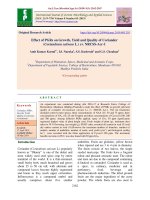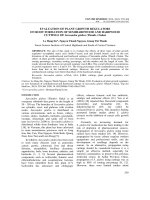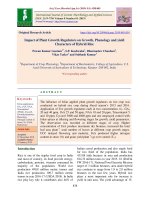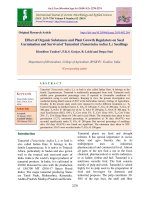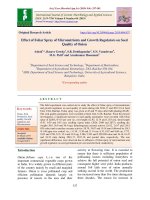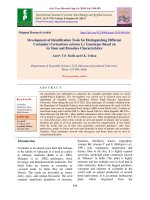Effect of fungicides and plant growth regulators on seed quality parameters of coriander (Coriandrum sativum L.) seeds
Bạn đang xem bản rút gọn của tài liệu. Xem và tải ngay bản đầy đủ của tài liệu tại đây (236.31 KB, 7 trang )
Int.J.Curr.Microbiol.App.Sci (2019) 8(9): 1213-1219
International Journal of Current Microbiology and Applied Sciences
ISSN: 2319-7706 Volume 8 Number 09 (2019)
Journal homepage:
Original Research Article
/>
Effect of Fungicides and Plant Growth Regulators on Seed Quality
Parameters of Coriander (Coriandrum sativum L.) Seeds
Anshu Pranay*, Bineeta M. Bara, Prashant Kumar Rai and Indrajit. P. Girase
Department of Genetics and Plant Beeding, Sam Higginbottom University of Agriculture,
Technology and Sciences, Prayagraj, 211007 U. P., India
*Corresponding author
ABSTRACT
Keywords
Coriander, Aged
seed, Fungicide and
Plant Growth
Regulator
Article Info
Accepted:
18 August 2019
Available Online:
10 September 2019
The experiment was conducted for overcoming the problems related to poor
germination and seedling establishment of coriander seeds at post graduate Seed
Testing Laboratory, Department of Genetics and Plant Breeding, Sam Higginbottom
University of Agriculture, Technology and Sciences, Pryagraj (U.P.) during rabi
season 2018, in order to standardize the best treatment of fungicide and PGRs to
Coriander (var.). Two method of pre-sowing treatment viz-fungicide and plant growth
regulators with control (Unprimed) were evaluated by screening 12 hour duration and
different concentrations viz.,- To- Control (untreated), T1- Captan (3 gm/kg), T2Captan (5 gm/kg), T3- Thiram (3 gm/kg), T4- Thiram (5 gm/kg), T5- Carbendazim (3
gm/kg), T6- Carbendazim (5 gm/kg), T7- GA3 (50 ppm), T8- GA3 (100 ppm), T9NAA (50 ppm), T10-NAA (100 ppm), T11- IAA (25 ppm), T12- IAA (50 ppm). It
was found that all the priming treatment showed significance difference with the
control and the highest germination per cent, seedling length, seedling fresh weight,
seedling dry weight, vigour indices were observed for Gibberellic Acid (100 ppm).
Highest germination was observed in Gibberellic Acid (100 ppm) and Captan
(5gm/kg). Seed pre-sowing treatment, its simplicity and no requirement for expensive
equipment and chemical could be used as a simple method for overcoming related to a
poor germination and seedling establishment and helps in sustaining agriculture and
cost effective and economic, non- toxic, eco-friendly sources.
Introduction
Coriander is an annual herb, which belongs to
the family Apiaceae and generally grown in
winter season as main crop in India. The name
of the plant is in fact derived from the Greek
word, ‘Korion’ which mean bug. In the food
industry, coriander is approved for food use by
the US Food and Drug Administration, the
Flavor and Extract Manufacturers Association
and the Council of Europe, and the plant can
be used as spice, medicine and a raw material
in food, beverage and pharmaceutical
industries. All parts of the plant are edible, but
the fresh leaves and dried seeds are most
commonly used in cooking. The essential oil
content of the dried seeds varies from 0.03%
to 2.7% (Purseglove et al., 1981; Bandara et
1213
Int.J.Curr.Microbiol.App.Sci (2019) 8(9): 1213-1219
al., 2000). The green leaves are consumed as
fresh herbs, in salads and as garnishes due to
its attractive green color and aroma (Norman
1990; Kamat et al., 2003). In Ayurvedic
medicine, the seeds are combined with
caraway and cardamom seeds or with
caraway, fennel and anise seeds in eastern
medicine to treat digestive complaints
(Aggarwal and Kunnumakkara, 2009).
The theory of seed priming was proposed by
(Heydecker, 1973). Basically it is a pre
sowing treatment in which seeds are soaked in
some way to a moisture level sufficient to
initiate the early events of germination
(imbibitions) but not sufficient to permit
radical protrusion. In the hormonal priming
gibberellin (GA3) and cytokinins (CKs)
control different developmental processes in
plants (Pospisilova, 2003). CKs act early
during shoot initiation and control meristem
activity, while All phytohormones exert their
regulatory role in close relation with each
other. During storage, a number of
physiological and physicochemical changes
occur, termed aging (Silva et al., 2005;
Sisman, 2005). Seed deterioration can be
defined as the loss of quality, viability and
vigour either due to aging or effect of adverse
environmental factors. Progress of technology
and industrialization of agricultural production
increased opportunities for long term seed
storage. The present experiment carried out to
evaluate the effect of different fungicide and
PGR treatment on seed quality parameters of
coriander seeds.
Materials and Methods
Seed of coriander variety Sicco, used for
conducting experiment. Present investigation
was carried out at Post-Graduate Laboratory
of Department of Genetics and Plant
Breeding, Sam Higginbottom, University of
Agriculture, Technology and Sciences,
Paryagraj (U.P.).
Procedure for Preparation of Solutions
Prepared solutions of the PGR and Fungicides,
one gram of each chemical taken in a beaker.
These chemicals will be added in 1000 ml. of
distilled water with constant stirring. The
volume of solution will finally constituted to
one litter, then it became 1000 ppm stock
solution of each chemical. Ten gram of each
chemical will be taken in a beaker. These
chemicals will be added in 1000 ml. of
distilled water with constant stirring. The
volume of solution will finally constituted to
one litter, then it became 1% stock solution of
each chemical.
Soaking of Seeds in Solution
After preparation of solution of GA3, NAA,
IAA and Thiram, Captan, Carbendazim,
Coriander seeds will be soaked in required
solution for 12 hour at 250C temperature.
Untreated seed is called as control. After 12
hrs of soaking the solution will be drained out
from the beaker and presoaked were air dried
to original weight and then placed for
germination in laboratory under controlled
condition.
Treatments details
S.No.
1
2
3
4
5
6
7
8
9
10
11
12
13
1214
Treatment
T0
T1
T2
T3
T4
T5
T6
T7
T8
T9
T10
T11
T12
Treatment combinations
Control
Captan (3gm/kg)
Captan (5gm/kg)
Thiram (3gm/kg)
Thiram (5gm/kg)
Carbendazim (3gm/kg)
Carbendazim (5gm/kg)
Gibberellic Acid (50 ppm)
Gibberellic Acid (100 ppm)
Napthyl AceticAcid (50 ppm)
Napthyl AceticAcid (100 ppm)
Indole Acetic Acid (25 ppm)
Indole Acetic Acid (50 ppm)
Duration
12 hours
12 hours
12 hours
12 hours
12 hours
12 hours
12 hours
12 hours
12 hours
12 hours
12 hours
12 hours
Int.J.Curr.Microbiol.App.Sci (2019) 8(9): 1213-1219
o
Data Analysis
In order to calculate the Speed of
Germination, Germination Percentage, Root,
Shoot and Seedling length, Seedling Fresh and
Dry Weight, Vigour Index (I and II) and
Electrical conductivity by using the following
formulas.
G1G2
S.P
temperature (25 C). After soaking the seed
steep water was decanted to obtain the seed
leachate.
Results and Discussion
Effect of different fungicide and PGRs on
germination
G
............ n
D1D2Dn
Root and shoot length:
Root and shoot length of five fresh seedlings
was measured in centimeters up to one
decimal. Total seedling length was calculated
by adding root and shoot length.
Seedling dry weight:
The seedlings used for recording were dried in
0
an oven at 103 C for 12 hours. Measurement
of dried samples was record on an electronic
balance upto three decimals in gm.
V.I. (I) = Germination percentage (Normal
seedling) X Seedling length (cm)
V. I. (II) = Germination percentage (Normal
seedling) X Dry weight of the seedling (gm)
E.C = Four replication of 25 seeds from each
treatment was drawn and pre-washed
thoroughly with distilled water to remove the
adhering chemical and then soaked in 50 ml of
distilled water for 16 hours at room
Pre-sowing seed treatment (priming) has been
used to improve germination, reduce seedling
emergence time, improve stand establishment
and yield. The beneficial effects of priming have
been demonstrated for many field crops. It is the
best solution of germination related problems
especially when crops are grown under
unfavorable conditions. It can enhance rates and
percentage of germination and seedling
emergence which ensure proper stand
establishmentunder a wide range of
environmental conditions.GA3 are responsible
for expansion and cell division in shoot
elongation, flowering and seed germination.
In the present study, seeds of Coriander
priming with different fungicide and PGRs
and used for sowing. Primed seed with
Gibberellic Acid (100 ppm) (T8) reported
maximum speed of germination and
germination percentage (0.3387 and 92.00%)
respectively. The minimum speed of
germination and germination percentage
observed in T0 (0.2779 and 67.00%)
respectively with control.
.
1215
Int.J.Curr.Microbiol.App.Sci (2019) 8(9): 1213-1219
Table.1 Effect of different fungicides and PGRs on seed quality parameters of oriander
S.
N
O.
Treatmen
ts
Speed of
Germinati
on
Germinati
on %
Root
Length
(cm)
Shoot
Length
(cm)
Seedling
Length
(cm)
1
T0
0.2779
67.00
3.22
2.22
2
T1
0.3328
87.25
5.35
3
Dry
Weight of
Seedling
(mg)
63.25
Seed
Vigour
Index-I
Seed
Vigour
Index-II
Electrical
Conductiv
ity
5.44
Fresh
Weight of
Seedling
(mg)
226.25
365.15
4245.25
0.511
3.95
9.30
385.00
91.00
811.42
7939.75
0.371
T2
0.3329
89.25
5.77
4.35
10.12
401.00
94.25
903.68
8411.81
0.368
4
T3
0.3213
83.00
4.80
3.77
8.57
354.75
85.00
711.72
7055.00
0.377
5
T4
0.3181
82.00
4.70
3.42
8.12
311.25
77.50
666.25
6355.00
0.396
6
T5
0.2954
75.75
4.40
3.07
7.47
288.75
73.25
566.22
5548.68
0.420
7
T6
0.3053
77.00
4.07
4.23
8.30
317.00
78.25
639.10
6025.25
0.413
8
T7
0.3357
90.00
5.92
4.42
10.34
418.25
94.50
931.50
8505.00
0.321
9
T8
0.3387
92.00
6.15
4.80
10.95
492.75
109.50
1007.40
10074.00
0.318
10
T9
0.2905
71.25
3.60
2.65
6.25
269.50
70.00
445.30
4987.50
0.464
11
T10
0.2811
70.00
3.47
2.38
5.85
243.75
72.25
409.50
5057.50
0.474
12
T11
0.3331
88.00
5.42
4.03
9.45
387.50
91.75
833.85
8074.00
0.392
13
T12
0.3318
85.75
5.17
3.80
8.97
361.75
87.50
769.60
7503.12
0.380
0.3150
81.40
4.77
3.62
8.39
342.88
83.69
696.97
6906.29
0.400
C.D.(5%)
0.022
7.64
0.87
0.73
1.53
64.80
11.91
122.46
1008.65
0.05
SE(m)
0.007
2.67
0.30
0.25
0.53
22.65
4.16
42.81
352.61
0.01
SE(d)
0.011
3.77
0.43
0.36
0.75
32.03
5.89
60.54
498.66
0.02
C.V.
4.955
6.56
12.77
14.24
12.75
13.21
9.95
12.28
10.21
8.87
Grand Mean
Similar results of Speed of germination was
observed by Greipsson (2001); Nehara et al.,
(2000); Pallaoro (2016); Jafri et al., (2015);
Sebastian et al., (2014); Verma and Sen
(2008) and Shetty and Rana (2012) as well as
Dotto and Silva (2017); Amrutavalli (1979);
Dissanayake et al., (2010); Ma et al., (2010)
and Sarada et al., (2008) founded similar
results in germination percentage.
Effect of different fungicide and PGRs on
seedling characters
Highest root length, shoot length and seedling
length was observed in (T8) Gibberellic Acid
(100 ppm) primed coriander seeds (6.15 cm,
4.80 cm, 10.95 cm) respectively. As well as
minimum root shoot and seedling length was
recorded in (T0) unprimed coriander seeds
(3.22 cm, 2.22 cm and 5.44 cm).
Similar results of Seedling length was
observed by Jafri et al., (2015); Stephen and
Jaybalan (1998); Verma and Sen (2008);
Nehara et al., (2000); Amrutavalli (1979);
Meenaria and Maliwal (2007); Moniruzzaman
(2011) and Singh (2014). Significantly highest
seedling fresh weight, dry weight, vigour
index I and II also reported in T8 Gibberellic
Acid (100 ppm) priming coriander seeds
(492.75 mg, 109.50 mg, 1007.40 and
10074.00) respectively, Minimum seedling
fresh weight, dry weight, vigour index I and II
observed in (T0) unprimed coriander seeds
(226.25 mg, 63.25 mg, 365.15 and 4245.25)
respectively.
1216
Int.J.Curr.Microbiol.App.Sci (2019) 8(9): 1213-1219
Dissanayake et al., (2010); Dhanapakiam et
al., (2008); Ghodrat et al., (2012); Pallaoro
(2016); Hussain et al., (2008) and Rajesh et
al., (2014) are also founded similar results
about Vigours parameters.
Technology and Sciences, Prayagraj, for
providing seeds of coriander and gave
permission to perform the research work at
Post-Graduate Laboratory of University.
References
Effect of different fungicide and PGRs on
electrical conductivity – dsm-1
Minimum electrical conductivity was recorded
by T8 (0.318) with application of Gibberellic
Acid (100 ppm) and highest electrical
conductivity (0.511) was reported in the
priming with T0 with control (100 ppm) in
coriander seed.
Many researchers also founded such type
results about electrical conductivity like
Saxena (1989);Verma and Sen (2008); Nehara
et al., (2000); Amrutavalli (1979) and
Sebastian et al., (2014)
The conclusion revealed that, pre-sowing
treatment with fungicide and PGRs effective
on germination and seed quality parameters,
increases the germinability and vigour of aged
coriander seed. In this experiment Gibberellic
Acid T8 (100 ppm) followed by Gibberellic
Acid T7 (50 ppm) and Captan T2 (5gm/kg)
significantly increase the germination and
vigour parameters of aged coriander seed
compare with all treatments and control. GA3
(100 ppm) showed maximum increase
germination and other parameters of aged
coriander seed, so GA3 was effective on aged
seed and enhance germination and seedling
parameters of coriander seed. These
conclusions are based on the results of six
months investigation and therefore further
investigation is needed to arrive at valid
recommendations.
Acknowledgement
Authors are thankful to Department of
Genetics
and
Plant
Beeding,
Sam
Higginbottom University of Agriculture,
Aggarwal BB, Kunnumakkara AB. (2009).
Molecular targets and therapeutic uses
of spices-modern uses for ancient
medicine. World Scientific Publishing:
Singapore.
Amrutavalli I (1979). Gibbererellic acid
(GA3) induced enhancement of
flowering in Bulgarian coriander
(Coriandrum Sativum L.) in relation to
changes in carbohydrate metabolism.
Curr. Sci. 48: 5-6.
Bandara M, Wildschut C, Russel E, Ost L,
Simo T, Weber J (2000). Special crops
program
(Brooks).
Alberta,
Agriculture,
Food,
and
Rural
Development. Crop Diversification
Centre 2000 Annual Report. Alberta,
Canada.
Dhanapakiam P, Joseph JM, Ramaswamy VK,
(2008). The cholesterol lowering
property
of
coriander
seeds
(Coriandrum sativum): mechanism of
action. J Environ Biol. 29(1):53–56.
Dissanayake, P., George, D. L. & Gupta, M.
L. (2010). Effect of light, gibberellic
acid and abscisic acid on germination
of guayule (Parthenium argentatum
Gray) seed. Ind. Crop Prod. 32, 111–
117.
Dotto, L. & Silva, V. N. (2017). Beet seed
priming with growth regulators.
Semina: Ciencias Agrarias. 38, 1785–
1798.
Ghodrat, V. & Rousta, M. J. (2012). Effect of
Priming with Gibberellic Acid (GA3)
on Germination and growth of corn
(Zea mays L.) under saline conditions.
Intl. J. Agri. Crop Sci. 4, 882–885.
Greipsson, S. (2001). Effects of stratification
1217
Int.J.Curr.Microbiol.App.Sci (2019) 8(9): 1213-1219
and GA3 on seed germination of a
sand
stabilising
grass
Leymus
arenarius used in reclamation. Seed
Sci. Technol. 29, 1–10.
Heydecker W. and Coolbear P. (1977). Seed
priming and performance survey and
attempted prognosis. Seed Science and
Technology.5:353-425.
Hussain M, Malik MA, Farooq M, (2008).
Improving Drought tolerance by
exogenous
application
of
glycinebetaine and salicylic acid in
sunflower. J Agron Crop Sci.
94(3):193–199
Jafri, N., Mazid, M. & Mohammad, F. (2015).
Responses of seed priming with
gibberellic acid on yield and oil quality
of sunflower (Helianthus annus L.).
Indian J. Agric. Res. 49, 235.
Kamat A, Pingulkar K, Bhushan B, Gholap A,
Thomas
P.
(2003).
Potential
application of low dose gamma
irradiation
to
improve
the
microbiological safety of fresh
coriander leaves. Food Cont 4: 529–
537.
Ma, H. Y., Liang, Z. W., Wu, H. T., Huang, L.
H. & Wang, Z. C. (2010). Role of
endogenous
hormones,
glumes,
endosperm and temperature on
germination of Leymus chinensis
(Poaceae) seeds during development.
J. Plant Ecol. 3, 269–277.
Meenaria B L & Maliwal P L (2007). Quality
of fennel as influenced by plant
density, Fertillization and plant growth
regulators. Indian Journal of Plant
Physiology. 12(1) 57-62.
Moniruzzaman M, (2011). Foliage and seed
production technology of coriander
(Doctoral Dessertation, Dept. of Hort.,
Bangabandhu Sheikh Mujibur Rahman
Agricultural University (BSMRAU),
Salna, Gazipur.
Nehara K C, Kumawat P D & Singh B P
(2000). Response of Fenugreek
(Trigonella
foenumgraceum)
to
phosphorus, sulphur and plant growth
regulators under semi arid eastern
plains zone of Rajasthan. Indian
Journal of Agronomy, 51(1) 73-76.
Norman J. (1990). The complete book of
spices. Dorling Kindersley Limited:
London.
Pallaoro, D. S. (2016). Priming corn seeds
with plant growth regulator. J. Seed
Sci. 38, 227–232.
Purseglove JW, Brown EG, Green CL,
Robbins SRJ (1981). Spices.
Rajesh, K., Reddy Narender, S., Reddy Pratap
Kumar, A. and Singh Gopal, B.
(2014). A comparative study of plant
growth regulators on morphological,
seed yield and quality parameters of
greengram. International J. Applied
Biology
and
Pharmaceutical
Technology. 5 (3): 103-109 (ISSN 9764550).
Sarada, C., Giridhar, K. and Yellamanda
Reddy, T. (2008). Effect of bioregulators and their time of application
on growth and yield of corian-der
(Coriandrum sativum). J. Spices Arom.
Crops., 17 : 183-86.
Sebastian, J., Wong, M. K., Tang, E. &
Dinneny, J. R. (2014). Methods to
promote germination of dormant
setaria viridis seeds. PLOS ONE 9,
e95109.
Shetty, A.A. and Rana, M. K. (2012). Effect
of Gibberellic acid on yield and seed
quality of ajowain (Trachyspermum
ammi L.). BIOINFOLET., 9 : 190- 194.
Sisman, C. (2005). Quality losses in
temporary sunflower stores and
influences of storage conditions on
quality losses during storage. Journal
of Central European Agriculture.6:
143-150.
Stephen, R. and Jaybalan, N. (1998). In vitro
flowering and seed setting formation
of coriander. Curr Science 74:195-198.
1218
Int.J.Curr.Microbiol.App.Sci (2019) 8(9): 1213-1219
Verma & Sen N L (2006). Effect of plant
growth regulators on vegetative growth
and seed yield of Coriander
(Coriandrum Sativum L.) CV. RCR435 Journal of Spices and aromatic
Crops Vol.15(2) : 118-122.
How to cite this article:
Anshu Pranay, Bineeta M. Bara, Prashant Kumar Rai and Indrajit. P. Girase 2019. Effect of
Fungicides and Plant Growth Regulators on Seed Quality Parameters of Coriander
(Coriandrum sativum L.) Seeds. Int.J.Curr.Microbiol.App.Sci. 8(09): 1213-1219.
doi: />
1219

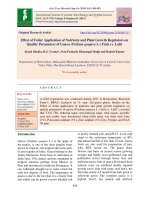
![Effect of different plant growth regulators on shooting of stem cuttings in dragon fruit [Hylocereus undatus (Haworth) Britton & Rose]](https://media.store123doc.com/images/document/2020_01/09/medium_isb1578564896.jpg)
